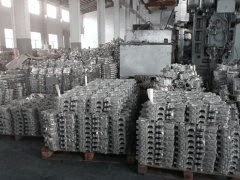Dies
are constructed with alloy tool steels and should have at least 2 sections. The
2 sections are known as the Fixed or even cover half, and also the release or
ejector fifty percent. The Ejector Half is made to permit removal associated
with casting. The Fixed die might have Spree Holes to permit molten metal in
order to enter and fill up the cavity. Portable slides, cores or additional
sections are use to create holes, threads along with other desired shapes. The
ejector fifty percent may contain athletes and gates in order to route molten
metal to the cavity. Locking Pins are utilized to keep both halves together
when the molten metal may be poured.
Hydraulic
Pressure can be used to hold both halves together. The top where the 2 halves
meet and lock is known as the "die separating line.” The projected surface
from the area being cast and also the pressure required in order to inject the
molten metal to the Die Casting Molds are both used
to look for the hydraulic pressure necessary to hold the 2 halves together or
even the clamping pressure. This pressure exerted about the materials should be
maintained before metal forms and solidifies to the desired shapes. Following
the metal gets hard, immediately open the actual die and take away the output
product. The wall
thickness of the injection-
Die Casting Molds
part is usually they vary from .080 to.160" while the thin wall mildew
wall thickness is often as low as.020". Shorter cycle occasions are
accomplished through ensuring the minimal wall thickness necessary for part
function as well as mold filling considerations be looked at during the mildew
design process. Too thinner parts weigh less which results in much less
material requirements as well as lower costs.
Another
part to keep in mind is that throughout cooling the slim section will harden
first, and the thicker sections will require longer. As the actual thicker
sections awesome, shrinkage will occur and also the material for the actual
shrinkage must originate from the un-solidified places. This builds stresses
between your thin and thick sections which often lead in order to warping
twisting or even cracking. Uniform wall width will reduce or eliminate this
issue. When uniform wall aren't possible then the actual change in section
ought to be as gradual as you possibly can.









